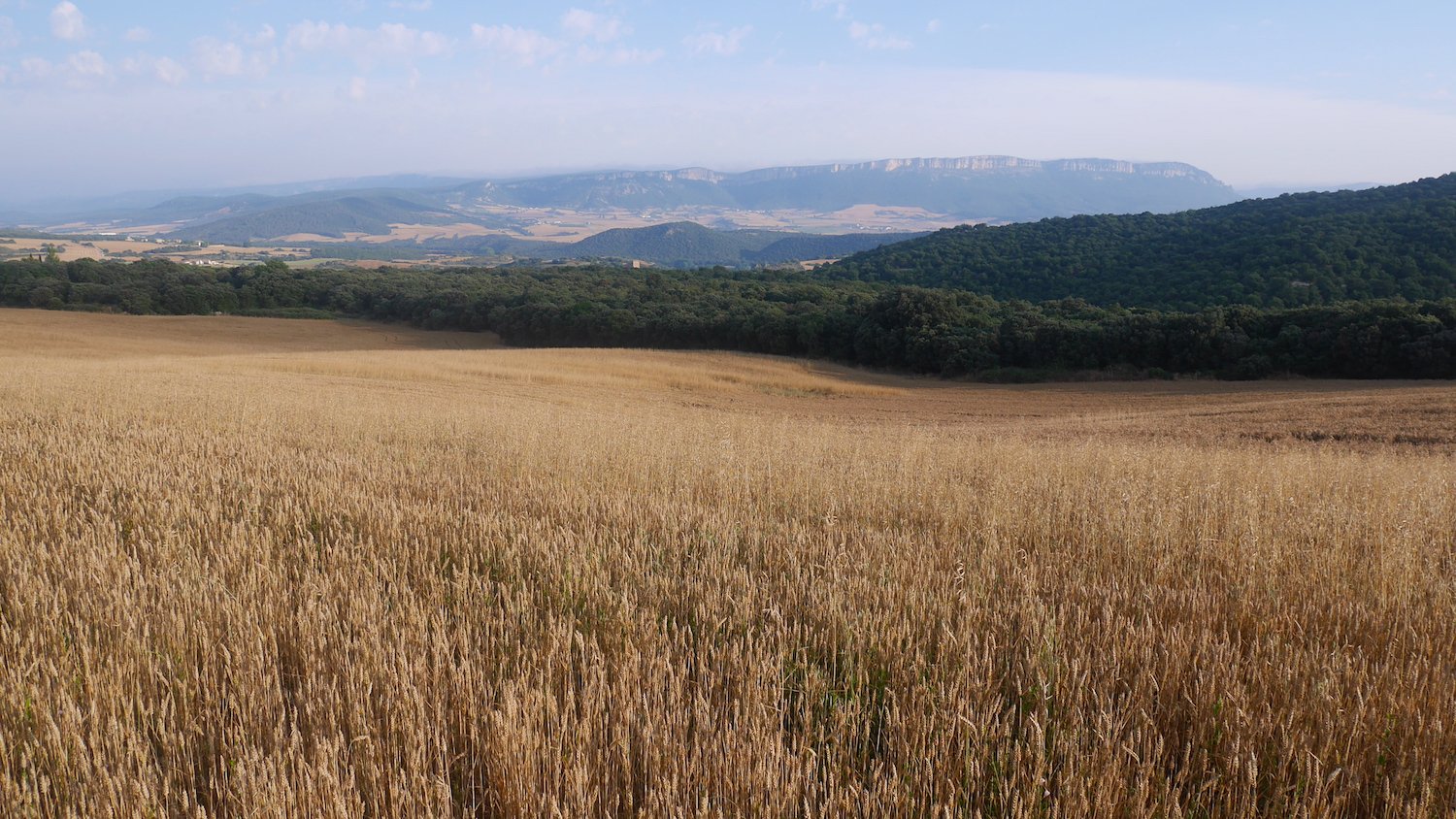The hills and valleys rolled south, evenly, like swells. The rising hills were forested and slightly wild while the troughs between them were thoroughly domesticated and partially harvested. Stations of stacked bales appeared here and there, fortresses of grass on a brittle-brown checkerboard.
It is big barley country between Estella and Los Arcos.
There were no workers in these fields on this day. It was hot. The flies were our companions.
Bob and I were as weary as the day was long. We made for an albergue known as Casa de la Abuela in the village of Los Arcos. The hostel had been recommended on some previous day by some previous person; I had written its name in my dog-eared notebook.
The breeze shifted, then picked up. This air was oddly familiar. I remembered it as a boy living in wind-swept Kansas. Weather never changes without announcement; the trick is learning to read the signs. Some say that the trees know when a rain is coming. Their bark swells and their leaves curl in anticipation. Others insist that it is not the coming moisture that you smell with your nose, but rather the odor of plants dumping waste. It smells like compost.
We sniffed the moving air and pushed on.
Hills and valleys rolled like swells as we approached Los Arcos. Image courtesy of Google maps.
We passed through one last gap and found ourselves in Los Arcos. It was a small and dusty place with tall houses painted in earthen tones all pressed together. The Río Odrón was its artery. It looked more like a crick than a río.
Life in this spot is ancient. Settlement goes back to the Roman period. Five tombs were found near the entrance to the town.*
Following the map in our guidebook, we found the Casa de la Abuela. Inside was Suzy from Essex, a solo traveler, and a couple that we had not met before from North Carolina. We had crossed paths with Suzy a couple of times.
The Casa de la Abuela was a lovely place, clean and welcoming.
Bob and I claimed our bunks and spend the late afternoon washing clothes, napping, reading.
While we relaxed inside, the clouds organized above . . . and then roiled. By late afternoon, they had had enough of it all and tore each other to pieces, spilling thunder, lightning, rain, and even hail. We all ran to the door and stood in a dry spot under the balcony and watched the show. Sheets of rain came down, followed by ice pellets. These ricocheted against walls and pavers. Tink . . . . . tink . . . tink . . tinktinktinktink!
They said, “the rain in Spain stays mainly in the plain.” Maybe. Maybe not. And nobody mentioned the hail.
A stream of water appeared and raced down the street looking for the Río Odró. At that moment I thanked God that we were not on the trail.
I went back inside to get my camera. I wanted to capture the steeple of Santa María de los Arcos against the ragged sky. I ran down the street, camera under my coat, and snapped a few pictures with one hand. With the other, I tried to shield the camera from the elements.
Before I was done the storm was over. It dissipated as quickly as it had arrived, leaving behind the sound of dripping water, and, as the sun regained its primacy, shiny puddles.
I sniffed. The air was fresh.
The church of Santa María de los Arcos is the focal point of the village.
That evening Bob and walked up the street to a local bar where a posterboard advertised paella. I didn’t know it at that moment, but this meal would become my go-to dinner in Spain. Cheap, carbohydrate-rich—full of saffron, rice, and beans—and presented while still bubbling in the skillet, it was a delight to the senses. On this damp night in Los Arcos we dined on our first paella. It was chicken, I recall clearly, with fresh bread. Many more skillets would be consumed after that stormy experience, topped with rabbit, seafood, chorizo, and various combinations thereof. Spain is no country for vegetarians.
¡Buen Camino!
*It is suggested that Los Arcos is Roman town of Curnonium, mentioned in Ptolemy’s Geography (Book II, Chapter V). If correct, it is one of the towns of a people group known as the Vascones. See Gitlitz and Davidson, The Pilgrimage Road to Santiago (2000): 113. For a fuller discussion of the remains of Los Arcos, consult the work by Javier Armendariz Martija posted here.
With travel restrictions easing, we have a full slate of Bible Land trips ready to launch in 2022. Check out a complete list by clicking here or perusing under the heading “Find your Trip.” For more information on how to join one of these trips or if you are interested in helping to craft a unique trip for your own group, church, or school, contact me at markziese@gmail.com.




